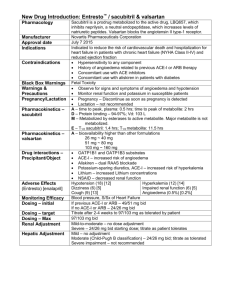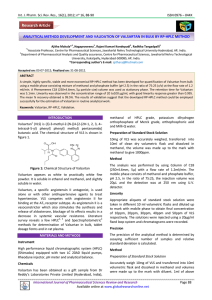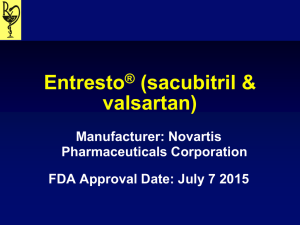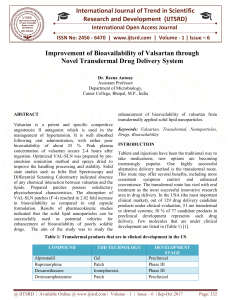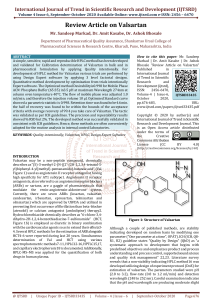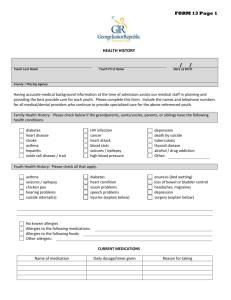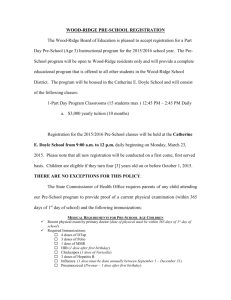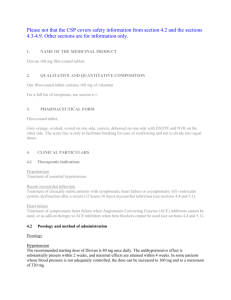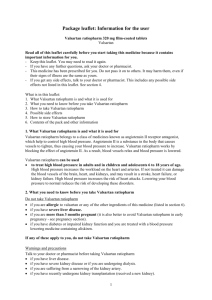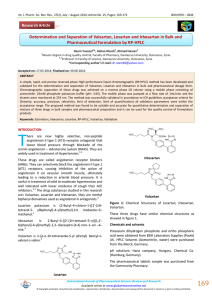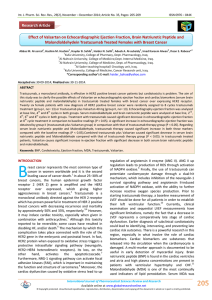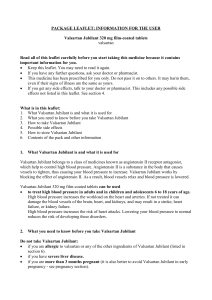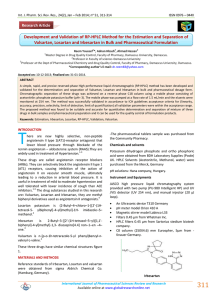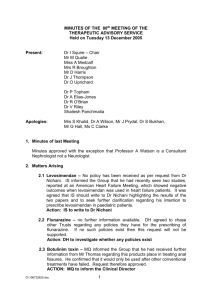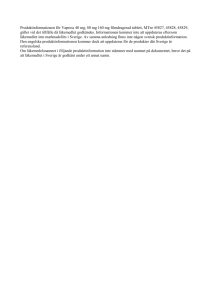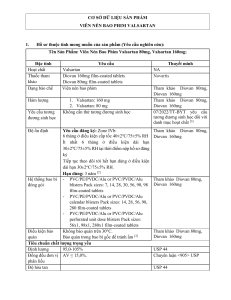Valsartan
advertisement
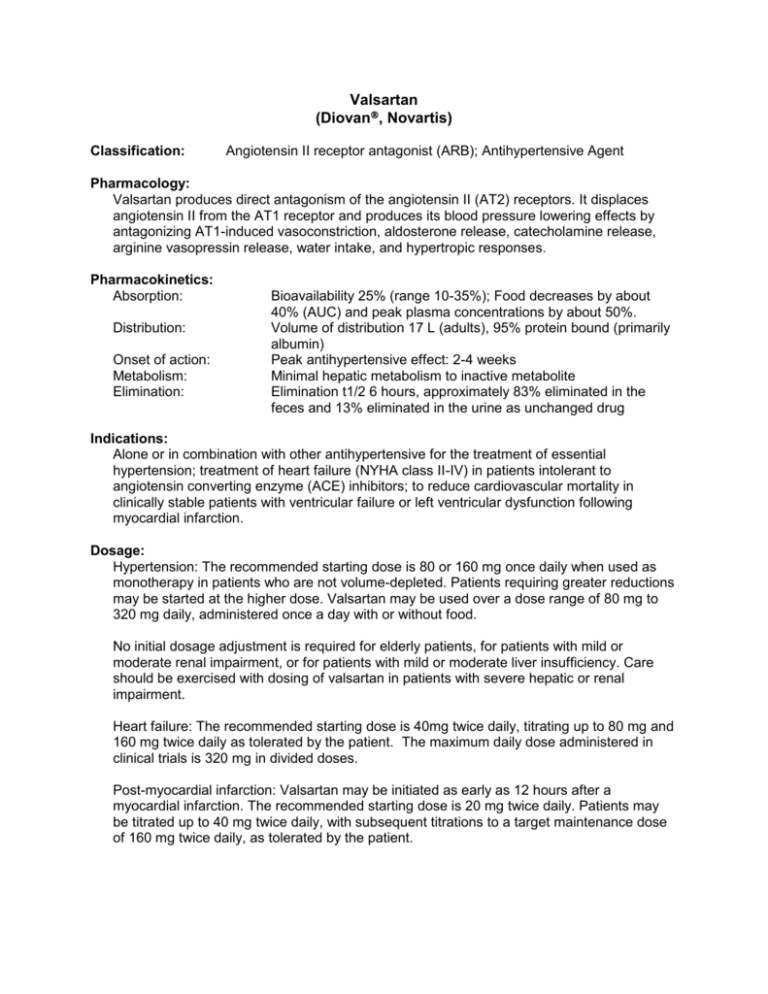
Valsartan (Diovan, Novartis) Classification: Angiotensin II receptor antagonist (ARB); Antihypertensive Agent Pharmacology: Valsartan produces direct antagonism of the angiotensin II (AT2) receptors. It displaces angiotensin II from the AT1 receptor and produces its blood pressure lowering effects by antagonizing AT1-induced vasoconstriction, aldosterone release, catecholamine release, arginine vasopressin release, water intake, and hypertropic responses. Pharmacokinetics: Absorption: Distribution: Onset of action: Metabolism: Elimination: Bioavailability 25% (range 10-35%); Food decreases by about 40% (AUC) and peak plasma concentrations by about 50%. Volume of distribution 17 L (adults), 95% protein bound (primarily albumin) Peak antihypertensive effect: 2-4 weeks Minimal hepatic metabolism to inactive metabolite Elimination t1/2 6 hours, approximately 83% eliminated in the feces and 13% eliminated in the urine as unchanged drug Indications: Alone or in combination with other antihypertensive for the treatment of essential hypertension; treatment of heart failure (NYHA class II-IV) in patients intolerant to angiotensin converting enzyme (ACE) inhibitors; to reduce cardiovascular mortality in clinically stable patients with ventricular failure or left ventricular dysfunction following myocardial infarction. Dosage: Hypertension: The recommended starting dose is 80 or 160 mg once daily when used as monotherapy in patients who are not volume-depleted. Patients requiring greater reductions may be started at the higher dose. Valsartan may be used over a dose range of 80 mg to 320 mg daily, administered once a day with or without food. No initial dosage adjustment is required for elderly patients, for patients with mild or moderate renal impairment, or for patients with mild or moderate liver insufficiency. Care should be exercised with dosing of valsartan in patients with severe hepatic or renal impairment. Heart failure: The recommended starting dose is 40mg twice daily, titrating up to 80 mg and 160 mg twice daily as tolerated by the patient. The maximum daily dose administered in clinical trials is 320 mg in divided doses. Post-myocardial infarction: Valsartan may be initiated as early as 12 hours after a myocardial infarction. The recommended starting dose is 20 mg twice daily. Patients may be titrated up to 40 mg twice daily, with subsequent titrations to a target maintenance dose of 160 mg twice daily, as tolerated by the patient. Contraindications and Precautions: Pregnancy category C (first trimester) and D (second and third trimesters) Known hypersensitivity to this product or any component of the product Severe hepatic or renal insufficiency. Possible increase in serum creatinine or blood urea nitrogen in patients with unilateral or bilateral renal artery stenosis Interactions: The enzyme(s) responsible or valsartan metabolism have not been identified but do not appear to be CYP 450 isozymes. Valsartan is a weak inhibitor of CYP 2C8/9, however, no clinically significant pharmacokinetic interactions have been reported Concomitant use of potassium sparing diuretics (e.g. spironolactone, triamterene, amiloride), potassium supplements, or salt substitutes containing potassium may lead to increases in serum potassium and in heart failure patients to increases in serum creatinine. In patients with an activated rennin-angiotensin system, such as volume-depleted and/or salt-depleted patients receiving high doses of diuretics, symptomatic hypotension may occur. Adverse Reactions: The overall frequency of adverse experiences was neither dose-related nor related to gender, race, age, or regimen. The most common reasons for discontinuation of therapy with valsartan were headache and dizziness (>1%). Other adverse experiences that occurred in placebo-controlled clinical trials included viral infection (3% vs 2%), fatigue (2% vs 1%), and abdominal pain (2% vs 1%). Costs and Monitoring: Daily costs range from $1.54 - $1.98 for once a day dosing. There is no FDA labeling requirement for monitoring, however, monitoring SCr/BUN, serum potassium levels, and CBC is generally recommended. How Supplied: Tablet: 40 mg, 80 mg, 160 mg, and 320 mg Efficacy: Hypertension: An oral dose of 80 mg inhibits the pressor effect by about 80% at peak with approximately 30% inhibition persisting for 24 hours. No information on the effect of larger doses is available. Administration of valsartan of patients with essential hypertension results in a significant reduction of sitting, supine, and standing systolic and diastolic blood pressure, usually with little or no orthostatic change. In most patients, after administration of a single oral dose, onset of antihypertensive activity occurs approximately 2 hours, and maximum reduction of blood pressure is achieved within 6 hours. The antihypertensive effects persists for 24 hours after dosing, but there is a decrease from peak effect at lower doses (40 mg) presumably reflecting lost of inhibition of angiotensin II. At higher doses, however (160 mg), there is little difference in peak and trough effect. In repeated dosing, the reduction in blood pressure with any dose is substantially present within 2 weeks, and maximal reduction is generally attained after 4 weeks. Heart failure: The Valsartan Heart Failure (Val-HeFT) was a multinational, double-blind study in which 5,010 patients with NYHA class II to IV heart failure and LVEF <40% were randomized to placebo or valsartan (titrated from 40mg twice daily to the highest tolerable dose or 160 mg twice daily). Results showed that patients on valsartan had a HF morbidity rate of 28.8%, while patients on placebo had a HF morbidity of 32.1% (p<0.009), with hazard ratio (95% CI) of 0.87 (0.79-0.97). Post-myocardial infarction: In VALsartan In Acute myocardial iNfarcTion trial (VALIANT) was randomized, controlled, multinational, double-blind study in 14.703 patients with acute myocardial infarction and either heart failure or left ventricular systolic dysfunction. Patients were randomized into three groups: valsartan, captopril, or the combination of valsartan plus captopril. The primary endpoint was time to all-cause mortality. The secondary endpoints included (1) time to cardiovascular (CV) mortality, and (2) time to the first event of cardiovascular mortality, reinfarction, or hospitalization for heart failure. The study showed that there was no significant difference in overall mortality among the three groups. There was thus no evidence that combining the ACE inhibitor captopril and the angiotensin II blocker valsartan was of value. Conclusions: Currently there are no angiotensin II receptor antagonists (ARBs) on the formulary. This class of drug may be beneficial as an alternative for patients who cannot tolerate ACE inhibitors. Currently there is inadequate information to suggest valsartan is more efficacious than other ARBs or ACE inhibitors. Compared to other ARBs, valsartan is slightly more expensive. Drug Valsartan Irbesartan Candesartan Olmesartan Telmisartan Losartan Price per tablet $1.54-$1.98 $1.42-$1.84 $1.36-$1.84 $1.36-$1.46 $1.48-$1.59 $1.38 Recommendation: Addition to the formulary is not recommended. References: 1. Lexi-Comp’s Drug Information Hanbook 13th edition (2005-2006). 2. Diovan Package Insert. Novartis Pharmaceuticals. East Hanover NJ, 2005. Prepared by: Quyen Ho & Annah Lopez, Pharm.D. Candidates University of Texas at Austin February 10, 2006
